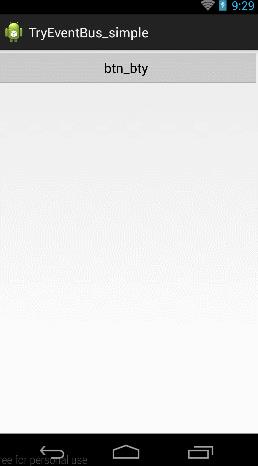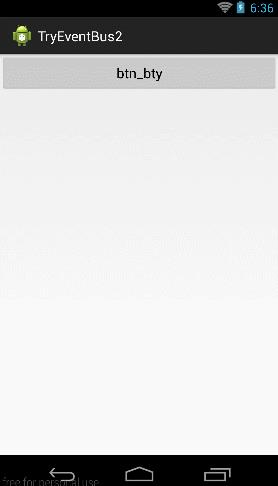EventBus使用详解
Posted 猫叔聊技术
tags:
篇首语:本文由小常识网(cha138.com)小编为大家整理,主要介绍了EventBus使用详解相关的知识,希望对你有一定的参考价值。
本文转载自:http://blog.csdn.net/harvic880925/article/details/40660137
看资料的时候看到eventBus 表示第一次看到不知道是什么就上完查查看,觉得这篇文章写得还不错,就mark下,以便后期查看。。。
1.初步使用EventBus
一、概述
EventBus是一款针对android优化的发布/订阅事件总线。主要功能是替代Intent,Handler,BroadCast在Fragment,Activity,Service,线程之间传递消息.优点是开销小,代码更优雅。以及将发送者和接收者解耦。
1、下载EventBus的类库
源码:https://github.com/greenrobot/EventBus
2、基本使用
(1)自定义一个类,可以是空类,比如:
public class AnyEventType
public AnyEventType()
(2)在要接收消息的页面注册:
eventBus.register(this); (3)发送消息
eventBus.post(new AnyEventType event); (4)接受消息的页面实现(共有四个函数,各功能不同,这是其中之一,可以选择性的实现,这里先实现一个):
public void onEvent(AnyEventType event) ; (5)解除注册
eventBus.unregister(this); 顺序就是这么个顺序,可真正让自己写,估计还是云里雾里的,下面举个例子来说明下。
首先,在EventBus中,获取实例的方法一般是采用EventBus.getInstance()来获取默认的EventBus实例,当然你也可以new一个又一个,个人感觉还是用默认的比较好,以防出错。
二、实战
先给大家看个例子:
当击btn_try按钮的时候,跳到第二个Activity,当点击第二个activity上面的First Event按钮的时候向第一个Activity发送消息,当第一个Activity收到消息后,一方面将消息Toast显示,一方面放入textView中显示。

按照下面的步骤,下面来建这个工程:
1、基本框架搭建
想必大家从一个Activity跳转到第二个Activity的程序应该都会写,这里先稍稍把两个Activity跳转的代码建起来。后面再添加EventBus相关的玩意。
MainActivity布局(activity_main.xml)
<LinearLayout xmlns:android="http://schemas.android.com/apk/res/android"
xmlns:tools="http://schemas.android.com/tools"
android:layout_width="match_parent"
android:layout_height="match_parent"
android:orientation="vertical">
<Button
android:id="@+id/btn_try"
android:layout_width="match_parent"
android:layout_height="wrap_content"
android:text="btn_bty"/>
<TextView
android:id="@+id/tv"
android:layout_width="wrap_content"
android:layout_height="match_parent"/>
</LinearLayout> 新建一个Activity,SecondActivity布局(activity_second.xml)
<LinearLayout xmlns:android="http://schemas.android.com/apk/res/android"
xmlns:tools="http://schemas.android.com/tools"
android:layout_width="match_parent"
android:layout_height="match_parent"
android:orientation="vertical"
tools:context="com.harvic.try_eventbus_1.SecondActivity" >
<Button
android:id="@+id/btn_first_event"
android:layout_width="match_parent"
android:layout_height="wrap_content"
android:text="First Event"/>
</LinearLayout> MainActivity.java (点击btn跳转到第二个Activity)
public class MainActivity extends Activity
Button btn;
@Override
protected void onCreate(Bundle savedInstanceState)
super.onCreate(savedInstanceState);
setContentView(R.layout.activity_main);
btn = (Button) findViewById(R.id.btn_try);
btn.setOnClickListener(new View.OnClickListener()
@Override
public void onClick(View v)
// TODO Auto-generated method stub
Intent intent = new Intent(getApplicationContext(),
SecondActivity.class);
startActivity(intent);
);
到这,基本框架就搭完了,下面开始按步骤使用EventBus了。
2、新建一个类FirstEvent
package com.harvic.other;
public class FirstEvent
private String mMsg;
public FirstEvent(String msg)
// TODO Auto-generated constructor stub
mMsg = msg;
public String getMsg()
return mMsg;
这个类很简单,构造时传进去一个字符串,然后可以通过getMsg()获取出来。
3、在要接收消息的页面注册EventBus:
在上面的GIF图片的演示中,大家也可以看到,我们是要在MainActivity中接收发过来的消息的,所以我们在MainActivity中注册消息。
通过我们会在OnCreate()函数中注册EventBus,在OnDestroy()函数中反注册。所以整体的注册与反注册的代码如下:
package com.example.tryeventbus_simple;
import com.harvic.other.FirstEvent;
import de.greenrobot.event.EventBus;
import android.app.Activity;
import android.content.Intent;
import android.os.Bundle;
import android.util.Log;
import android.view.View;
import android.widget.Button;
import android.widget.TextView;
import android.widget.Toast;
public class MainActivity extends Activity
Button btn;
TextView tv;
@Override
protected void onCreate(Bundle savedInstanceState)
super.onCreate(savedInstanceState);
setContentView(R.layout.activity_main);
//注册EventBus
EventBus.getDefault().register(this);
btn = (Button) findViewById(R.id.btn_try);
tv = (TextView)findViewById(R.id.tv);
btn.setOnClickListener(new View.OnClickListener()
@Override
public void onClick(View v)
// TODO Auto-generated method stub
Intent intent = new Intent(getApplicationContext(),
SecondActivity.class);
startActivity(intent);
);
@Override
protected void onDestroy()
super.onDestroy();
EventBus.getDefault().unregister(this);//反注册EventBus
4、发送消息
发送消息是使用EventBus中的Post方法来实现发送的,发送过去的是我们新建的类的实例!
EventBus.getDefault().post(new FirstEvent("FirstEvent btn clicked")); 完整的SecondActivity.java的代码如下:
package com.example.tryeventbus_simple;
import com.harvic.other.FirstEvent;
import de.greenrobot.event.EventBus;
import android.app.Activity;
import android.os.Bundle;
import android.view.View;
import android.widget.Button;
public class SecondActivity extends Activity
private Button btn_FirstEvent;
@Override
protected void onCreate(Bundle savedInstanceState)
super.onCreate(savedInstanceState);
setContentView(R.layout.activity_second);
btn_FirstEvent = (Button) findViewById(R.id.btn_first_event);
btn_FirstEvent.setOnClickListener(new View.OnClickListener()
@Override
public void onClick(View v)
// TODO Auto-generated method stub
EventBus.getDefault().post(
new FirstEvent("FirstEvent btn clicked"));
);
5、接收消息
接收消息时,我们使用EventBus中最常用的onEventMainThread()函数来接收消息,具体为什么用这个,我们下篇再讲,这里先给大家一个初步认识,要先能把EventBus用起来先。
在MainActivity中重写onEventMainThread(FirstEvent event),参数就是我们自己定义的类:
在收到Event实例后,我们将其中携带的消息取出,一方面Toast出去,一方面传到TextView中;
public void onEventMainThread(FirstEvent event)
String msg = "onEventMainThread收到了消息:" + event.getMsg();
Log.d("harvic", msg);
tv.setText(msg);
Toast.makeText(this, msg, Toast.LENGTH_LONG).show();
完整的MainActiviy代码如下:
package com.example.tryeventbus_simple;
import com.harvic.other.FirstEvent;
import de.greenrobot.event.EventBus;
import android.app.Activity;
import android.content.Intent;
import android.os.Bundle;
import android.util.Log;
import android.view.View;
import android.widget.Button;
import android.widget.TextView;
import android.widget.Toast;
public class MainActivity extends Activity
Button btn;
TextView tv;
@Override
protected void onCreate(Bundle savedInstanceState)
super.onCreate(savedInstanceState);
setContentView(R.layout.activity_main);
EventBus.getDefault().register(this);
btn = (Button) findViewById(R.id.btn_try);
tv = (TextView)findViewById(R.id.tv);
btn.setOnClickListener(new View.OnClickListener()
@Override
public void onClick(View v)
// TODO Auto-generated method stub
Intent intent = new Intent(getApplicationContext(),
SecondActivity.class);
startActivity(intent);
);
public void onEventMainThread(FirstEvent event)
String msg = "onEventMainThread收到了消息:" + event.getMsg();
Log.d("harvic", msg);
tv.setText(msg);
Toast.makeText(this, msg, Toast.LENGTH_LONG).show();
@Override
protected void onDestroy()
super.onDestroy();
EventBus.getDefault().unregister(this);
好了,到这,基本上算初步把EventBus用起来了,下面再讲讲EventBus的几个函数,及各个函数间是如何识别当前如何调用哪个函数的。
EventBus使用详解(二)——EventBus使用进阶
一、概述
前一篇给大家装简单演示了EventBus的onEventMainThread()函数的接收,其实EventBus还有另外有个不同的函数,他们分别是:
1、onEvent
2、onEventMainThread
3、onEventBackgroundThread
4、onEventAsync
这四种订阅函数都是使用onEvent开头的,它们的功能稍有不同,在介绍不同之前先介绍两个概念:
告知观察者事件发生时通过EventBus.post函数实现,这个过程叫做事件的发布,观察者被告知事件发生叫做事件的接收,是通过下面的订阅函数实现的。
onEvent:如果使用onEvent作为订阅函数,那么该事件在哪个线程发布出来的,onEvent就会在这个线程中运行,也就是说发布事件和接收事件线程在同一个线程。使用这个方法时,在onEvent方法中不能执行耗时操作,如果执行耗时操作容易导致事件分发延迟。
onEventMainThread:如果使用onEventMainThread作为订阅函数,那么不论事件是在哪个线程中发布出来的,onEventMainThread都会在UI线程中执行,接收事件就会在UI线程中运行,这个在Android中是非常有用的,因为在Android中只能在UI线程中跟新UI,所以在onEvnetMainThread方法中是不能执行耗时操作的。
onEventBackground:如果使用onEventBackgrond作为订阅函数,那么如果事件是在UI线程中发布出来的,那么onEventBackground就会在子线程中运行,如果事件本来就是子线程中发布出来的,那么onEventBackground函数直接在该子线程中执行。
onEventAsync:使用这个函数作为订阅函数,那么无论事件在哪个线程发布,都会创建新的子线程在执行onEventAsync.
二、实战
1、解析
上面列出的这四个函数,关键问题在于,我们怎么指定调用哪个函数呢?
我们先研究一下,上一篇中是怎么调用的onEventMainThread函数,除了在接收端注册与反注册以后,关键问题在于新建的一个类:
新建一个类:
package com.harvic.other;
public class FirstEvent
private String mMsg;
public FirstEvent(String msg)
// TODO Auto-generated constructor stub
mMsg = msg;
public String getMsg()
return mMsg;
发送时:
EventBus.getDefault().post(new FirstEvent("FirstEvent btn clicked")); 接收时:
public void onEventMainThread(FirstEvent event)
……
发现什么问题了没?
没错,发送时发送的是这个类的实例,接收时参数就是这个类实例。
所以!!!!!!当发过来一个消息的时候,EventBus怎么知道要调哪个函数呢,就看哪个函数传进去的参数是这个类的实例,哪个是就调哪个。那如果有两个是呢,那两个都会被调用!!!!
为了证明这个问题,下面写个例子,先看下效果
2、实例
先看看我们要实现的效果:
这次我们在上一篇的基础上,新建三个类:FirstEvent、SecondEvent、ThirdEvent,在第二个Activity中发送请求,在MainActivity中接收这三个类的实例,接收时的代码为:
public void onEventMainThread(FirstEvent event)
Log.d("harvic", "onEventMainThread收到了消息:" + event.getMsg());
public void onEventMainThread(SecondEvent event)
Log.d("harvic", "onEventMainThread收到了消息:" + event.getMsg());
public void onEvent(ThirdEvent event)
Log.d("harvic", "OnEvent收到了消息:" + event.getMsg());
使用两个onEventMainThread分别接收FirstEvent实例的消息和SecondEvent实例的消息,使用onEvent接收ThirdEvent实例的消息。界面操作及结果如下:

Log输出结果:

可以看到,在发送FirstEvent时,在MainActiviy中虽然有三个函数,但只有第一个onEventMainThread函数的接收参数是FirstEvent,所以会传到它这来接收。所以这里识别调用EventBus中四个函数中哪个函数,是通过参数中的实例来决定的。
因为我们是在上一篇例子的基础上完成的,所以这里的代码就不详细写了,只写改动的部分。
1、三个类
package com.harvic.other;
public class FirstEvent
private String mMsg;
public FirstEvent(String msg)
// TODO Auto-generated constructor stub
mMsg = msg;
public String getMsg()
return mMsg;
package com.harvic.other;
public class SecondEvent
private String mMsg;
public SecondEvent(String msg)
// TODO Auto-generated constructor stub
mMsg = "MainEvent:"+msg;
public String getMsg()
return mMsg;
package com.harvic.other;
public class ThirdEvent
private String mMsg;
public ThirdEvent(String msg)
// TODO Auto-generated constructor stub
mMsg = msg;
public String getMsg()
return mMsg;
2、发送
然后在SecondActivity中新建三个按钮,分别发送不同的类的实例,代码如下:
package com.harvic.tryeventbus2;
import com.harvic.other.FirstEvent;
import com.harvic.other.SecondEvent;
import com.harvic.other.ThirdEvent;
import de.greenrobot.event.EventBus;
import android.app.Activity;
import android.os.Bundle;
import android.view.View;
import android.widget.Button;
public class SecondActivity extends Activity
private Button btn_FirstEvent, btn_SecondEvent, btn_ThirdEvent;
@Override
protected void onCreate(Bundle savedInstanceState)
super.onCreate(savedInstanceState);
setContentView(R.layout.activity_second);
btn_FirstEvent = (Button) findViewById(R.id.btn_first_event);
btn_SecondEvent = (Button) findViewById(R.id.btn_second_event);
btn_ThirdEvent = (Button) findViewById(R.id.btn_third_event);
btn_FirstEvent.setOnClickListener(new View.OnClickListener()
@Override
public void onClick(View v)
// TODO Auto-generated method stub
EventBus.getDefault().post(
new FirstEvent("FirstEvent btn clicked"));
);
btn_SecondEvent.setOnClickListener(new View.OnClickListener()
@Override
public void onClick(View v)
// TODO Auto-generated method stub
EventBus.getDefault().post(
new SecondEvent("SecondEvent btn clicked"));
);
btn_ThirdEvent.setOnClickListener(new View.OnClickListener()
@Override
public void onClick(View v)
// TODO Auto-generated method stub
EventBus.getDefault().post(
new ThirdEvent("ThirdEvent btn clicked"));
);
3、接收
在MainActivity中,除了注册与注册,我们利用onEventMainThread(FirstEvent event)来接收来自FirstEvent的消息,使用onEventMainThread(SecondEvent event)接收来自SecondEvent 实例的消息,使用onEvent(ThirdEvent event) 来接收ThirdEvent 实例的消息。
package com.harvic.tryeventbus2;
import com.harvic.other.FirstEvent;
import com.harvic.other.SecondEvent;
import com.harvic.other.ThirdEvent;
import de.greenrobot.event.EventBus;
import android.app.Activity;
import android.content.Intent;
import android.os.Bundle;
import android.util.Log;
import android.view.Menu;
import android.view.MenuItem;
import android.view.View;
import android.widget.Button;
import android.widget.TextView;
public class MainActivity extends Activity
Button btn;
TextView tv;
EventBus eventBus;
@Override
protected void onCreate(Bundle savedInstanceState)
super.onCreate(savedInstanceState);
setContentView(R.layout.activity_main);
EventBus.getDefault().register(this);
btn = (Button) findViewById(R.id.btn_try);
btn.setOnClickListener(new View.OnClickListener()
@Override
public void onClick(View v)
// TODO Auto-generated method stub
Intent intent = new Intent(getApplicationContext(),
SecondActivity.class);
startActivity(intent);
);
public void onEventMainThread(FirstEvent event)
Log.d("harvic", "onEventMainThread收到了消息:" + event.getMsg());
public void onEventMainThread(SecondEvent event)
Log.d("harvic", "onEventMainThread收到了消息:" + event.getMsg());
public void onEvent(ThirdEvent event)
Log.d("harvic", "OnEvent收到了消息:" + event.getMsg());
@Override
protected void onDestroy()
// TODO Auto-generated method stub
super.onDestroy();
EventBus.getDefault().unregister(this);
到这里,代码就结束 了,从上面的代码,我们可以看到,EventBus是怎么接收消息的,是根据参数中类的实例的类型的判定的,所以当如果我们在接收时,同一个类的实例参数有两个函数来接收会怎样?答案是,这两个函数都会执行,下面实验一下:
在MainActivity中接收时,我们在接收SecondEvent时,在上面onEventMainThread基础上另加一个onEventBackgroundThread和onEventAsync,即下面的代码:
//SecondEvent接收函数一
public void onEventMainThread(SecondEvent event)
Log.d("harvic", "onEventMainThread收到了消息:" + event.getMsg());
//SecondEvent接收函数二
public void onEventBackgroundThread(SecondEvent event)
Log.d("harvic", "onEventBackground收到了消息:" + event.getMsg());
//SecondEvent接收函数三
public void onEventAsync(SecondEvent event)
Log.d("harvic", "onEventAsync收到了消息:" + event.getMsg());
完整的代码在这里:
package com.harvic.tryeventbus2;
import com.harvic.other.FirstEvent;
import com.harvic.other.SecondEvent;
import com.harvic.other.ThirdEvent;
import de.greenrobot.event.EventBus;
import android.app.Activity;
import android.content.Intent;
import android.os.Bundle;
import android.util.Log;
import android.view.Menu;
import android.view.MenuItem;
import android.view.View;
import android.widget.Button;
import android.widget.TextView;
public class MainActivity extends Activity
Button btn;
TextView tv;
EventBus eventBus;
@Override
protected void onCreate(Bundle savedInstanceState)
super.onCreate(savedInstanceState);
setContentView(R.layout.activity_main);
EventBus.getDefault().register(this);
btn = (Button) findViewById(R.id.btn_try);
btn.setOnClickListener(new View.OnClickListener()
@Override
public void onClick(View v)
// TODO Auto-generated method stub
Intent intent = new Intent(getApplicationContext(),
SecondActivity.class);
startActivity(intent);
);
public void onEventMainThread(FirstEvent event)
Log.d("harvic", "onEventMainThread收到了消息:" + event.getMsg());
//SecondEvent接收函数一
public void onEventMainThread(SecondEvent event)
Log.d("harvic", "onEventMainThread收到了消息:" + event.getMsg());
//SecondEvent接收函数二
public void onEventBackgroundThread(SecondEvent event)
Log.d("harvic", "onEventBackground收到了消息:" + event.getMsg());
//SecondEvent接收函数三
public void onEventAsync(SecondEvent event)
Log.d("harvic", "onEventAsync收到了消息:" + event.getMsg());
public void onEvent(ThirdEvent event)
Log.d("harvic", "OnEvent收到了消息:" + event.getMsg());
@Override
protected void onDestroy()
// TODO Auto-generated method stub
super.onDestroy();
EventBus.getDefault().unregister(this);
经过上面的分析,当发送SecondEvent实例的消息过来的时候,这三个函数会同时接收到并各自执行,所以当点击Second Event这个button的时候,会出现下面的结果:
好啦,这篇就到了,讲来讲去就是说一个问题:消息的接收是根据参数中的类名来决定执行哪一个的;
参考文章:
《Android解耦库EventBus的使用和源码分析》:http://blog.csdn.net/yuanzeyao/article/details/38174537
《EventBus的使用初试》:http://blog.csdn.net/pp_hdsny/article/details/14523561
《EventBusExplained 》:https://code.google.com/p/guava-libraries/wiki/EventBusExplained
《Google Guava EventBus实例与分析》
友情链接:http://timding.me
如果我的文章有帮到你,请关注哦。
源码地址:http://download.csdn.net/detail/harvic880925/8111357
以上是关于EventBus使用详解的主要内容,如果未能解决你的问题,请参考以下文章